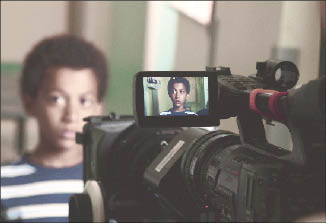|

On film: IRIM uses its young clients to bring in more volunteers. Source: IRIM.
|
In the new world of social media, youth development organizations are struggling to keep up. Often short-staffed and cash-strapped, youth agencies may at first think the world of Facebook and Twitter is just one more thing to keep up with. But as more and more organizations are discovering, social media can be a cheap (and sometimes free) way of staying connected with supporters, donors and kids. One way a number of youth organizations are reaching out online is through video.
Organizations say their videos are used most frequently to appeal to donors and supporters, but that involving youths in video production aids in their development.
“Moving pictures and immediate access to information are taking over traditional print media,” says Jonathan Zeichner, executive director of A Place Called Home in Los Angeles.
“It’s incumbent upon us in youth work to get in the curve. If we want to get the word out, we have to understand relationships between different forms of social media,” Zeichner says.
In his view, that means getting videos posted not only on the organization web site and on YouTube, but also on Facebook and MySpace pages. He’s already encouraging his own staff to link their Facebook and MySpace pages back to those of APCH.
Make it Real, Make it Accessible
For the Children’s Aid Society in New York, video has made the organization’s programs all the more real to potential funders, sponsors, and supporters. “What we’re trying to do is bring our programs and their impact to life,” says Associate Director of Development and Director of Marketing and Events Kathy Gallagher de Meij. She points out that when parents and children get in front of a camera and talk about their struggles, it really makes an impact.
Children’s Aid, which supports at-risk youth with programs from pregnancy prevention to college prep training, uses video for a variety of purposes, including as a marketing tool and as a medium for education. Sometimes one video can cover multiple angles. “Anything directed to a potential donor is going to talk about problems and their solutions,” de Meij says.
With social media, getting one’s video out to the world is easier than ever. Many youth organizations have their own channels on YouTube, and some are either posting (or about to post) video to their MySpace and Facebook pages. Posting videos on any of these sites is free.
Linking to these videos in emails is another free avenue of promotion. De Meij says she makes use of this option often, especially when in communication with donors and sponsors. “When you see it, you can feel it,” she says. “Keep it short and compelling. Send it to all your supporters, and encourage them to share it as well.”
Know Your Message, Use Your Kids
De Meij says it’s important to think about why you want to make a video in the first place. “Lay out the script, figure out why you’re doing it, and what you want people to take away,” she says. Then she advises keeping the whole thing under five minutes; three minutes is even better.
You don’t necessarily have to hire professionals either. Most youth organizations use their own youth, staff and parents for the videos, whether they are on the screen or off – helping with script writing or filming.
But be certain to take the proper legal steps. “Get everyone to sign a release first,” de Meij says. “It’s not that hard. Usually people are clamoring to be in these.”
Zeichner agrees, pointing out that youth members of A Place Called Home (APCH) are only too happy to promote the organization, which provides a safe place for tutoring, mentoring and help with college counseling and preparation. Getting video release forms signed by parents has never been a problem for APCH. “We’re so connected into the kids’ families,” Zeichner says. “There has to be a parent or guardian to even sign them into the organization.”
The video production itself can be a youth development tool. Children’s Aid tries to ensure that kids are involved in the process whenever practicable. “The kids are acknowledging the problems they’re facing,” she says of those who have been filmed. “They also feel good about being in a production. It’s a huge thing to them, and they’ll remember it.”
Zeichner says including kids in the production also makes the video more authentic to whoever is watching it. “Don’t worry about making it too slick,” he says. “Just make sure there is a call to action.”
Production can be as simple as using a handycam, downloading the video to a personal computer and then uploading the video to a YouTube account. Nonprofits can create their own YouTube channels for free. The videos can then be accessed either through a link on the nonprofit’s website, or through a quick search on YouTube for the organization’s channel.
At the other end of the spectrum are the videos produced for youth organizations by pricey professional firms. Recently the Boy Scouts of America produced 759: Boy Scouts of Harlem, to promote their organization and its contributions to youth development. The film had its premier screening last month in Washington, D.C. right on Capitol Hill under the sponsorship of Sen. Jeff Sessions (R-Ala.) and Ben Nelson (D-Neb.).
To get a professionally produced video without paying lots of cash, de Meij suggests reaching out to supporters who may work in video as part of their jobs or as a hobby. Often these videographers and editors will work for free on a nonprofit’s presentation. Children’s Aid usually hires someone to do video editing, but the organization often has staff do the recording, using just a tripod to hold the camera steady for filming. The group has also used in-kind donations from media companies.
Check out how these organizations are producing their videos:
Children’s Aid Society
New York, N.Y.
212-949-4800
http://www.childrensaidsociety.org
Videos: http://media.childrensaidsociety.org/videos
|

The stars: About 100 youths at the Children’s Aid Society have participated in making videos, either in front of the camera, as here, or as part of writing and preparation. Photo Credit: Andrew Walker
|
The Strategy: Use videos to bring Children’s Aid Society programs and their impact to life to garner the attention of donors, sponsors and supporters.
Getting Started: The 156-year-old Children’s Aid Society, which serves some 150,000 kids annually at 45 sites in New York City, provides at-risk youth and their families support through programs ranging from prenatal counseling and pregnancy prevention instruction to college preparatory training. The organization first began using videos in their annual meetings as a complement to their annual report, providing an alternate method for communicating their mission, work and goals. A year ago, the organization started its own YouTube channel, first putting up existing videos from annual meetings and then making new videos geared toward gaining the attention of would-be donors and sponsors and also as part of its youth development work.
How It Works: First, Children’s Aid decides the purpose of the video and then develops a script, often with the help of youth participants. Then, depending on the video’s purpose, the organization has staff members film the video or hires a professional videographer. For example, an appeal to a major donor would probably warrant professionals. Once the video has been edited and finalized, Children’s Aid posts it on its website and on its YouTube channel. In addition, Children’s Aid always provides links to relevant videos in e-mails to potential donors, sponsors and supporters.
Youth Served: To date, about 100 young people, ages 5 to 24, have assisted in video production.
Staff: Three Children’s Aid staff are involved in video promotion work. The organization sometimes hires videographers and editors or has adult volunteers work to film and edit the videos.
Money: The organizations spends $300 to $5,000 on each video, depending on whether the video is professionally produced or made entirely in-house. The money to develop the videos comes from the organization’s marketing budget; there is no separate budget for video production.
Results: Children’s Aid Society’s Associate Director of Development Kathy Gallagher de Meij says results of the organization’s video promotion efforts are largely anecdotal so far; the group’s YouTube channel has received 2,000 views. De Meij said she’s received direct response donations to the group’s “Children’s Aid Text To Give” video. She also sends video links in her e-mails to potential funders and sponsors. “We’ve brought in sponsorship because of the videos,” she says. “Video really piques their interest. It may not be direct response, but it’s lifting the boat overall.”
A Place Called Home
Los Angeles, Calif.
(323) 232-7653
http://www.apch.org
Videos: http://www.youtube.com/watch?v=VJfmE4FsjRA
|

Taking Part: Kids at A Place Called Home are at home on video. Photo Credit: A Place Called HOme
|
The Strategy: Use video production to increase media literacy for young people, both as creators and consumers of media, and as a tool to gain funders, educate colleagues and gain new constituents.
Getting Started: A Place Called Home (APCH) provides a safe place for young people to receive tutoring and mentoring services, including college and career counseling, as well as instruction in the arts. APCH has its own dance academy, programs in learning to play musical instruments, and instruction in studio engineering. It has been making videos in one form or another for the last five years, though the organization only began posting them on YouTube within the last two years. The group is also in the early stages of creating its own “Channel APCH” with the help of sponsor Time Warner. The channel will be viewable both from APCH’s website and, eventually, on Time Warner’s cable access network. “We just got 12 handycams for the project,” says APCH’s new Executive Director Jonathan Zeichner, “and we’re asking staff to shoot something every day.”
How It Works: Zeichner, who has been with APCH just three months, says the organization hasn’t promoted its videos very well, but he plans to change that through the new relationship with Time Warner. He says APCH is starting a new media program that will involve youth in the writing and creation of storylines, and, ultimately, producing videos, all of which will be used to reach out to supporters, potential partners, volunteers and the public in general. Up to this point, kids have participated in making the videos as part of their own youth development and in recruiting more participants. The youth have recounted on video their experiences in APCH’s music program and performed for the camera. In addition, youth in the organization’s music program have made their own videos, which also can be accessed on the APCH’s YouTube channel.
APCH staff often shoot the video, but it also uses professional video crews for more targeted videos, such as those they show to donors or potential donors at fundraising events.
Youth Served: Zeichner says at least 100 APCH members have participated in the organization’s videos so far. Those kids range in age from 8 to 20. The organization as a whole has registered more than 400 youth members, but because of a lack of facilities and staff, 200 of those are on a waiting list to participate in APCH’s programs and services.
Staff: APCH has one full-time staff person devoted to the organization’s art studio, and she devotes part of her time to video production work. Zeichner says about 10 of the organization’s more than two dozen staff are involved in video production on one level or another, more often than not in videoing material.
Money: Zeichner says the cost to produce a video averages about $1,000 per minute. APCH does not have funding specifically for video production but recently used part of an $8,000 grant from the California Consumer Protection Foundation to buy 12 handycams.
Results: Results of APCH’s use of video are largely anecdotal, though Zeichner says that about a third of the people he interacts with outside the organization say they have watched one or more of APCH’s videos. Some of the group’s YouTube channel videos have received nearly 10,000 views since going live, and, as the comments on the videos indicate, more than a few of those viewers are the very young people the organization serves or hopes to serve.
Interfaith Refugee and Immigration Ministries
Chicago, Ill.
(773) 989-5647
http://www.irim.org
Video: http://www.youtube.com/watch?v=FIvvG49Wsfw
The Strategy: Use video to educate partners and inspire funders.
Getting Started: Interfaith Refugee and Immigration Ministries (IRIM) has been making videos about the organization’s work for about five years. Those videos include reviews of its Youth Program, which offers after-school tutoring, mentoring, and recreation as well as summer day camps to the children of refugee and immigrant families. IRIM helps immigrant families navigate the U.S. educational system, assisting with school registration and preparation. Two years ago, IRIM started putting their videos on YouTube. “The reason was to expand our support, donor, and volunteer base,” says Joan Worthem Leech, IRIM’s director of development and external relations.
How It Works: Unlike a number of other youth organizations that have waded into the world of video production, IRIM does not, at this point, involve youth in video production beyond putting them in front of the camera. “Our purpose is to show the power of a refugee coming to this country to start a new life,” says Leech. “The visual is really moving,” Leech says, especially if it includes children. Leech often shows videos at benefit dinners to move funders to action or at churches to garner new volunteers.
Youth Served: At any given time, IRIM serves about 100 to 120 young people in grades K through 12, and 30 to 40 of those youths have appeared in IRIM videos.
Staff: Of the organization’s 30 staff, one to two of them typically work on a video in production, though IRIM usually hires a videographer to assist. The group has often obtained videography service pro bono from professionals interested in helping with the organization’s work.
Money: Leech says that when IRIM is able to get free help from professional videographers, their cost per video is generally about $1,000 to $1,500.
Results: Leech says IRIM has gained new volunteers through the use of video, though mainly when videos have been shown in formalized settings, such as at a meeting with a church congregation. “I would say we’ve garnered more new potential supporters through the use of video, too,” she says, “particularly as we become more expert at making sure our message is very clear.”





























